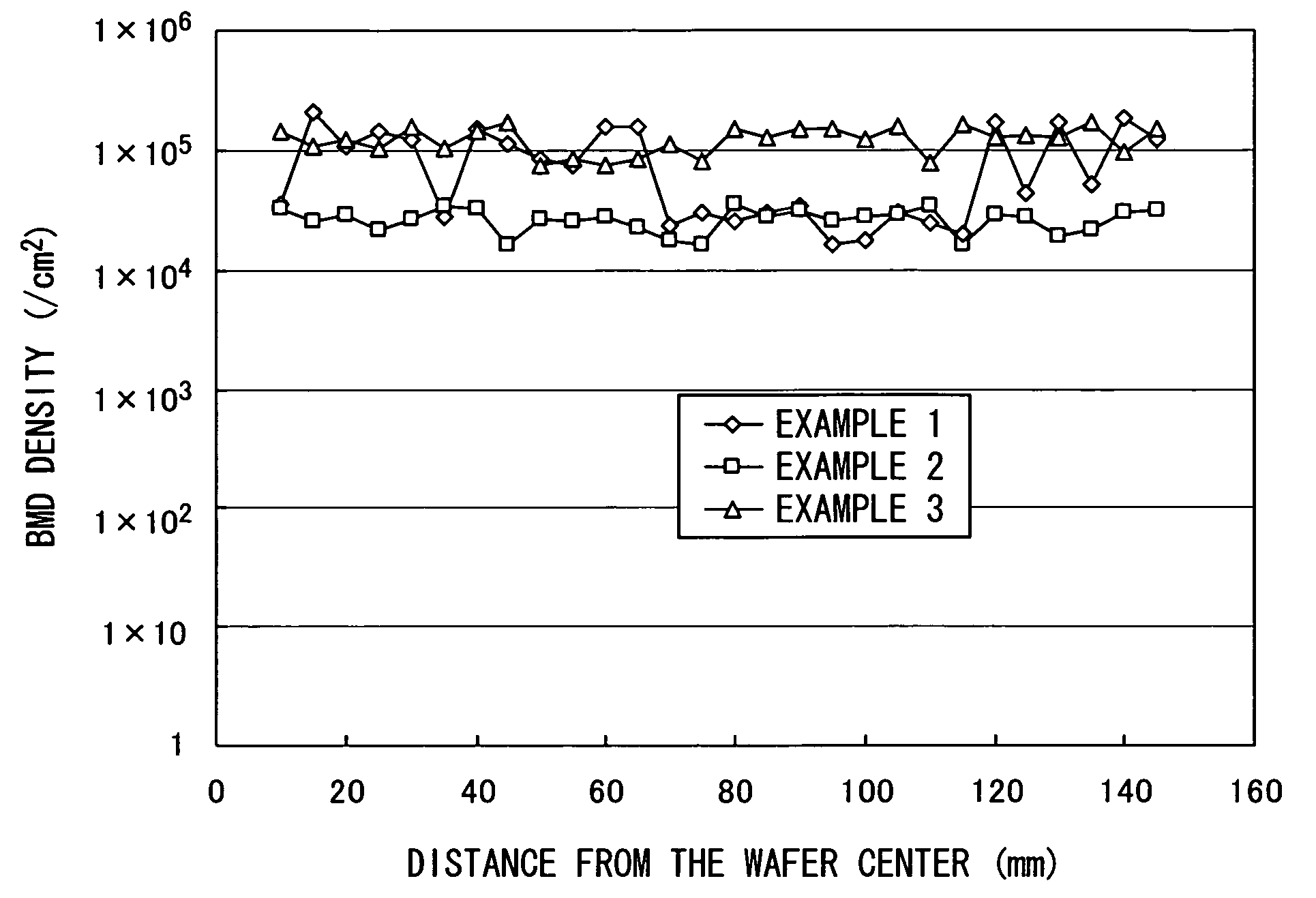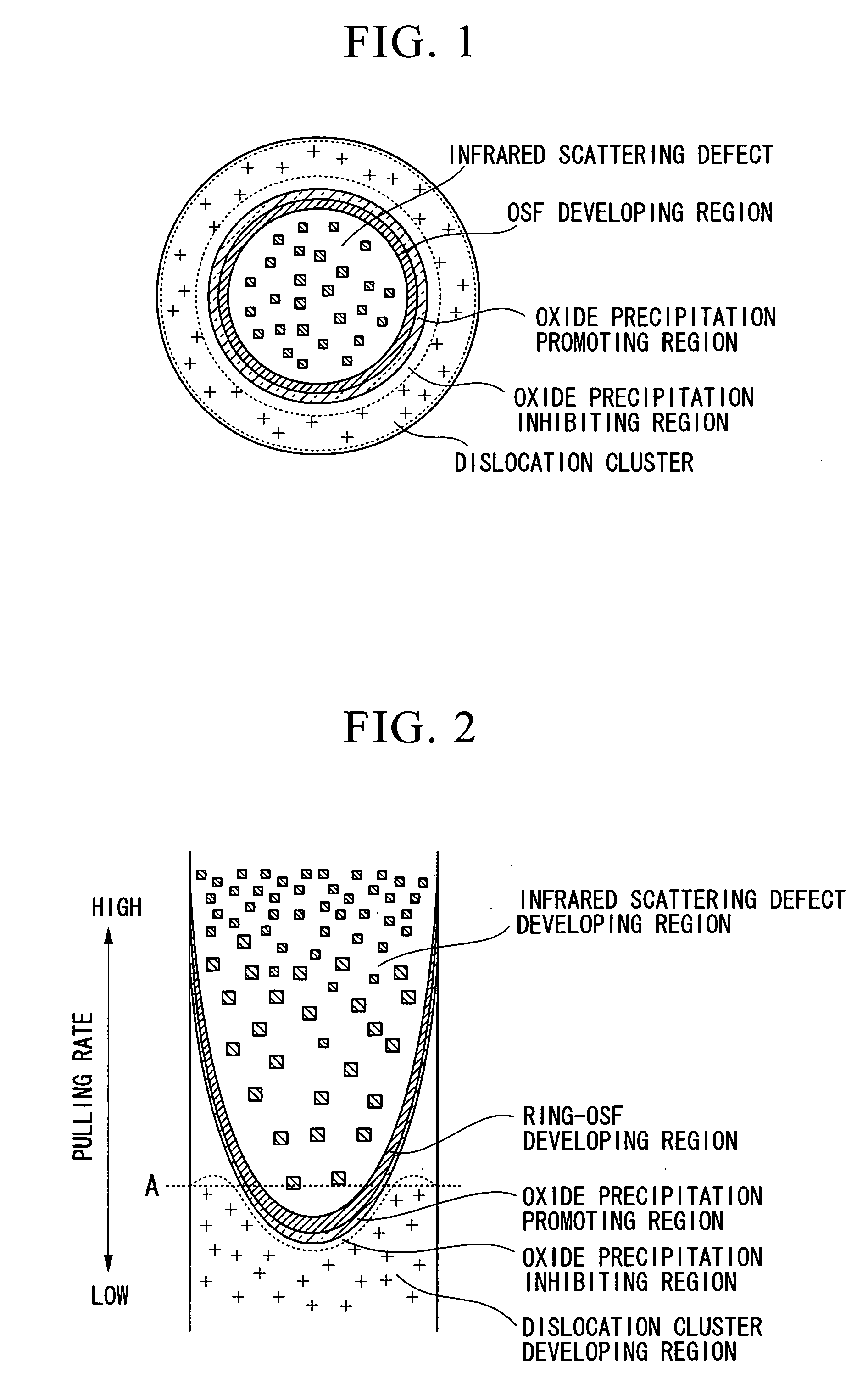Method for growing silicon single crystal and method for manufacturing silicon wafer
a single crystal and silicon technology, applied in the direction of crystal growth process polycrystalline material growth, etc., can solve the problem that the extent of the pulling rate margin of the defect-free crystal is still insufficient to grow silicon, and the adverse effect of device characteristics may be exerted, so as to achieve the effect of sufficient gettering capability
- Summary
- Abstract
- Description
- Claims
- Application Information
AI Technical Summary
Benefits of technology
Problems solved by technology
Method used
Image
Examples
examples
[0102] To verify the invention, experiments described below have been carried out.
examples 1 to 3
[0103] Using a growth apparatus having the undermentioned hot zone structure 1, under operation conditions determined by the above-described method, defect-free crystals of silicon single crystals having oxygen concentrations shown in Table 1 were grown as an embodiment of the present invention. A crucible is charged with 300 kg of polycrystalline silicon of high purity. A mixed gas mixing hydrogen into argon was used as an atmospheric gas. In the mixed gas, hydrogen gas was mixed to have a hydrogen molecule partial pressure of 240 Pa. The silicon single crystals were grown to have a diameter of 300 mm and a body length of 1600 mm.
TABLE 1Oxygen ConcentrationOSF ConcentrationExample(×1017 atoms / cm3)(pieces / cm2)Crystal Region113-1414PV Region +PI Region213-140PI Region314-150PI Region
[Hot Zone Structure 1]
[0104] The CZ furnace shown in FIG. 8 was used. The water cooling unit 8 had a cooling capacity expressed in the form of its inside diameter of 600 mm and height of 200 mm. The wa...
examples 4 and 5
[0105] Using a crystal growth apparatus having the undermentioned hot zone structure 2 defect-free crystals of silicon single crystals having oxygen concentrations shown in Table 2 were grown as comparative examples of the present invention. As like as Example 1, crucible is charged with 300 kg of polycrystalline silicon of high purity. Argon was used as an atmospheric gas. The silicon single crystals were grown to have a diameter of 300 mm and a body length of 1600 mm.
TABLE 2OxygenOSFExampleConcentrationConcentration(Comparative)(×1017 atoms / cm3)(pieces / cm2)Crystal Region411.5-12.570OSF Region +PV Region +PI Region513-14>1000OSF Region +PV Region +PI Region
[Hot Zone Structure 2]
[0106] A CZ furnace having neither the water cooling unit 8 nor the heat shield 7 was used. A horizontal magnetic field was supplied as in the case of the hot zone structure 1. A hot zone structure was provided to realize an axial thermal gradient Gc of 2.8° C. / mm at the central portion of the crystal bet...
PUM
| Property | Measurement | Unit |
|---|---|---|
| melting point | aaaaa | aaaaa |
| temperature | aaaaa | aaaaa |
| partial pressure | aaaaa | aaaaa |
Abstract
Description
Claims
Application Information
 Login to View More
Login to View More - R&D
- Intellectual Property
- Life Sciences
- Materials
- Tech Scout
- Unparalleled Data Quality
- Higher Quality Content
- 60% Fewer Hallucinations
Browse by: Latest US Patents, China's latest patents, Technical Efficacy Thesaurus, Application Domain, Technology Topic, Popular Technical Reports.
© 2025 PatSnap. All rights reserved.Legal|Privacy policy|Modern Slavery Act Transparency Statement|Sitemap|About US| Contact US: help@patsnap.com



